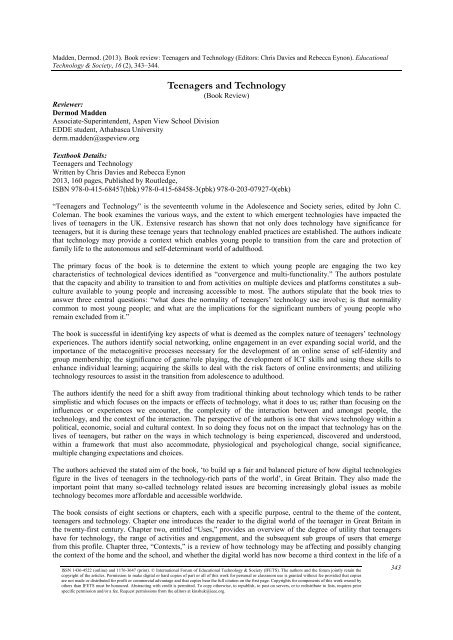Download Complete Issue in PDF - Educational Technology & Society
Download Complete Issue in PDF - Educational Technology & Society
Download Complete Issue in PDF - Educational Technology & Society
You also want an ePaper? Increase the reach of your titles
YUMPU automatically turns print PDFs into web optimized ePapers that Google loves.
Madden, Dermod. (2013). Book review: Teenagers and <strong>Technology</strong> (Editors: Chris Davies and Rebecca Eynon). <strong>Educational</strong><br />
<strong>Technology</strong> & <strong>Society</strong>, 16 (2), 343–344.<br />
Reviewer:<br />
Dermod Madden<br />
Associate-Super<strong>in</strong>tendent, Aspen View School Division<br />
EDDE student, Athabasca University<br />
derm.madden@aspeview.org<br />
Teenagers and <strong>Technology</strong><br />
(Book Review)<br />
Textbook Details:<br />
Teenagers and <strong>Technology</strong><br />
Written by Chris Davies and Rebecca Eynon<br />
2013, 160 pages, Published by Routledge,<br />
ISBN 978-0-415-68457(hbk) 978-0-415-68458-3(pbk) 978-0-203-07927-0(ebk)<br />
“Teenagers and <strong>Technology</strong>” is the seventeenth volume <strong>in</strong> the Adolescence and <strong>Society</strong> series, edited by John C.<br />
Coleman. The book exam<strong>in</strong>es the various ways, and the extent to which emergent technologies have impacted the<br />
lives of teenagers <strong>in</strong> the UK. Extensive research has shown that not only does technology have significance for<br />
teenagers, but it is dur<strong>in</strong>g these teenage years that technology enabled practices are established. The authors <strong>in</strong>dicate<br />
that technology may provide a context which enables young people to transition from the care and protection of<br />
family life to the autonomous and self-determ<strong>in</strong>ant world of adulthood.<br />
The primary focus of the book is to determ<strong>in</strong>e the extent to which young people are engag<strong>in</strong>g the two key<br />
characteristics of technological devices identified as “convergence and multi-functionality.” The authors postulate<br />
that the capacity and ability to transition to and from activities on multiple devices and platforms constitutes a subculture<br />
available to young people and <strong>in</strong>creas<strong>in</strong>g accessible to most. The authors stipulate that the book tries to<br />
answer three central questions: “what does the normality of teenagers’ technology use <strong>in</strong>volve; is that normality<br />
common to most young people; and what are the implications for the significant numbers of young people who<br />
rema<strong>in</strong> excluded from it.”<br />
The book is successful <strong>in</strong> identify<strong>in</strong>g key aspects of what is deemed as the complex nature of teenagers’ technology<br />
experiences. The authors identify social network<strong>in</strong>g, onl<strong>in</strong>e engagement <strong>in</strong> an ever expand<strong>in</strong>g social world, and the<br />
importance of the metacognitive processes necessary for the development of an onl<strong>in</strong>e sense of self-identity and<br />
group membership; the significance of game/role play<strong>in</strong>g, the development of ICT skills and us<strong>in</strong>g these skills to<br />
enhance <strong>in</strong>dividual learn<strong>in</strong>g; acquir<strong>in</strong>g the skills to deal with the risk factors of onl<strong>in</strong>e environments; and utiliz<strong>in</strong>g<br />
technology resources to assist <strong>in</strong> the transition from adolescence to adulthood.<br />
The authors identify the need for a shift away from traditional th<strong>in</strong>k<strong>in</strong>g about technology which tends to be rather<br />
simplistic and which focuses on the impacts or effects of technology, what it does to us; rather than focus<strong>in</strong>g on the<br />
<strong>in</strong>fluences or experiences we encounter, the complexity of the <strong>in</strong>teraction between and amongst people, the<br />
technology, and the context of the <strong>in</strong>teraction. The perspective of the authors is one that views technology with<strong>in</strong> a<br />
political, economic, social and cultural context. In so do<strong>in</strong>g they focus not on the impact that technology has on the<br />
lives of teenagers, but rather on the ways <strong>in</strong> which technology is be<strong>in</strong>g experienced, discovered and understood,<br />
with<strong>in</strong> a framework that must also accommodate, physiological and psychological change, social significance,<br />
multiple chang<strong>in</strong>g expectations and choices.<br />
The authors achieved the stated aim of the book, ‘to build up a fair and balanced picture of how digital technologies<br />
figure <strong>in</strong> the lives of teenagers <strong>in</strong> the technology-rich parts of the world’, <strong>in</strong> Great Brita<strong>in</strong>. They also made the<br />
important po<strong>in</strong>t that many so-called technology related issues are becom<strong>in</strong>g <strong>in</strong>creas<strong>in</strong>gly global issues as mobile<br />
technology becomes more affordable and accessible worldwide.<br />
The book consists of eight sections or chapters, each with a specific purpose, central to the theme of the content,<br />
teenagers and technology. Chapter one <strong>in</strong>troduces the reader to the digital world of the teenager <strong>in</strong> Great Brita<strong>in</strong> <strong>in</strong><br />
the twenty-first century. Chapter two, entitled “Uses,” provides an overview of the degree of utility that teenagers<br />
have for technology, the range of activities and engagement, and the subsequent sub groups of users that emerge<br />
from this profile. Chapter three, “Contexts,” is a review of how technology may be affect<strong>in</strong>g and possibly chang<strong>in</strong>g<br />
the context of the home and the school, and whether the digital world has now become a third context <strong>in</strong> the life of a<br />
ISSN 1436-4522 (onl<strong>in</strong>e) and 1176-3647 (pr<strong>in</strong>t). © International Forum of <strong>Educational</strong> <strong>Technology</strong> & <strong>Society</strong> (IFETS). The authors and the forum jo<strong>in</strong>tly reta<strong>in</strong> the<br />
copyright of the articles. Permission to make digital or hard copies of part or all of this work for personal or classroom use is granted without fee provided that copies<br />
are not made or distributed for profit or commercial advantage and that copies bear the full citation on the first page. Copyrights for components of this work owned by<br />
others than IFETS must be honoured. Abstract<strong>in</strong>g with credit is permitted. To copy otherwise, to republish, to post on servers, or to redistribute to lists, requires prior<br />
specific permission and/or a fee. Request permissions from the editors at k<strong>in</strong>shuk@ieee.org.<br />
343

















